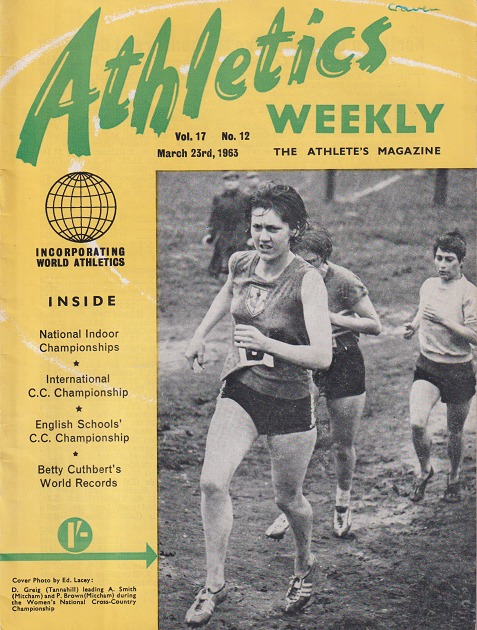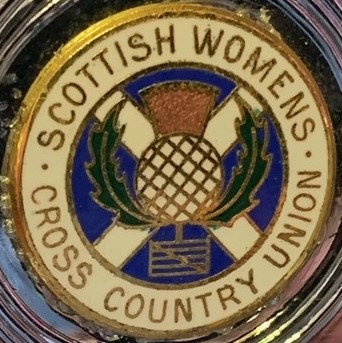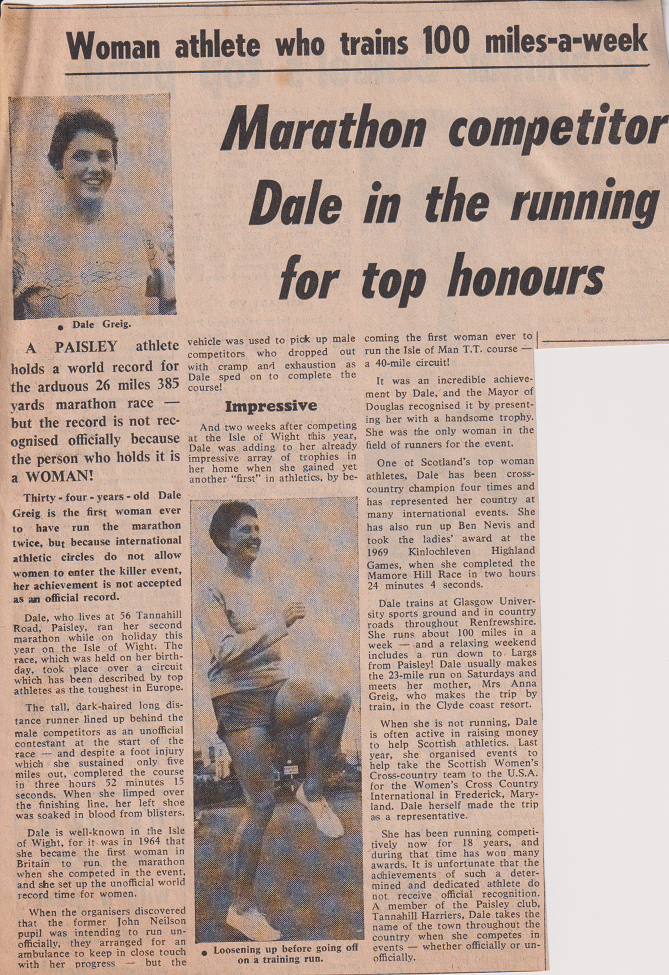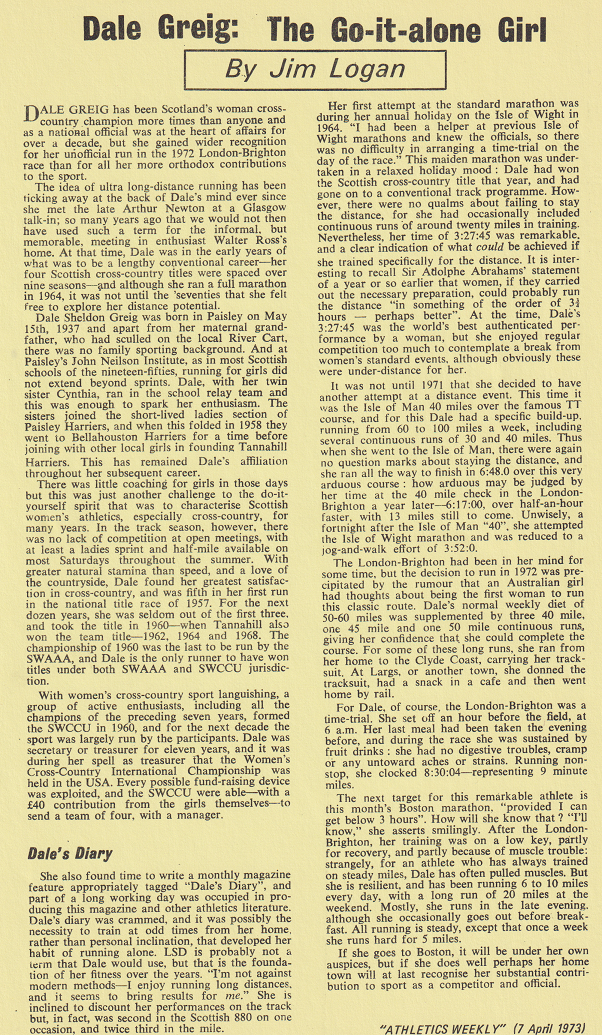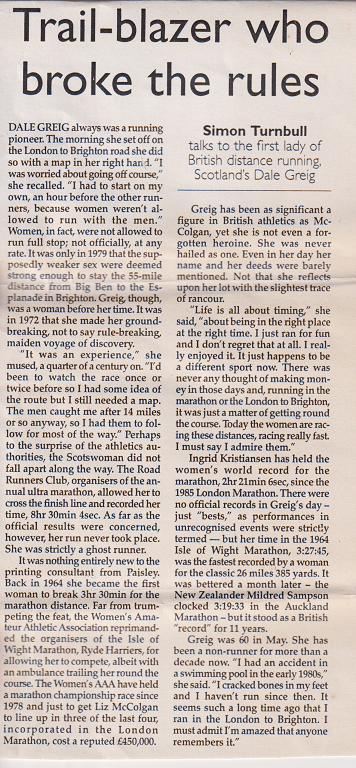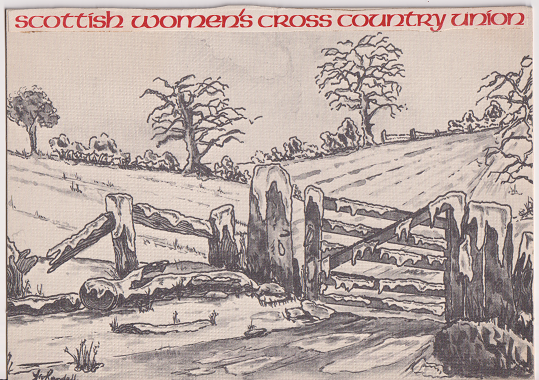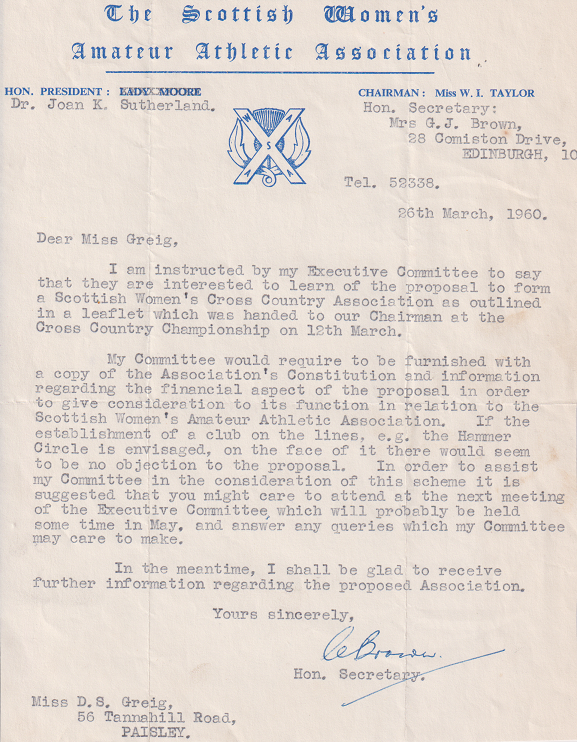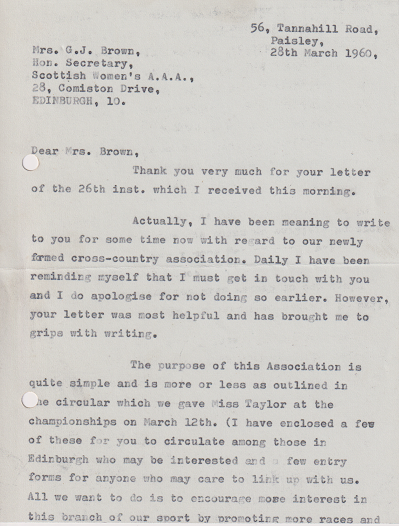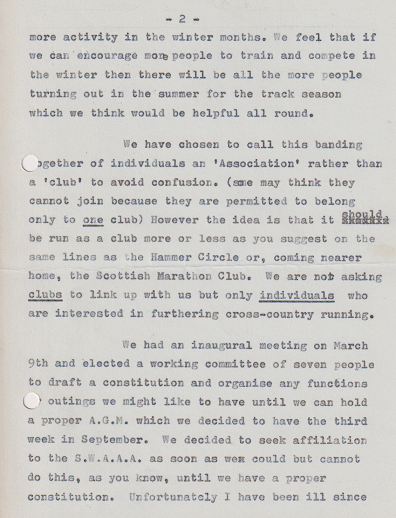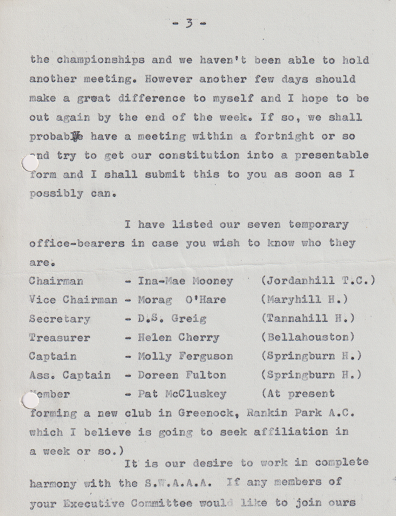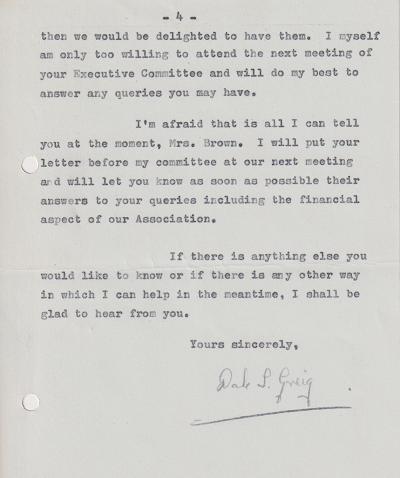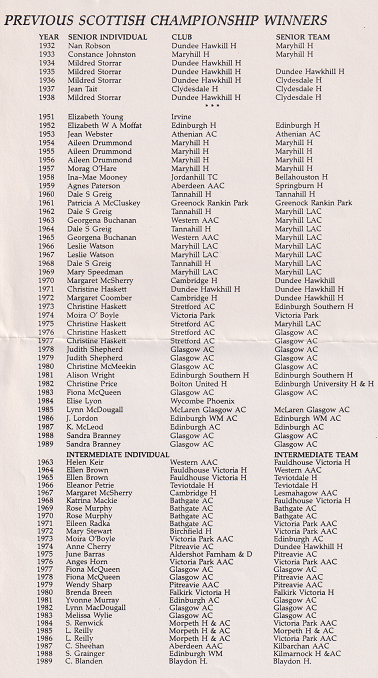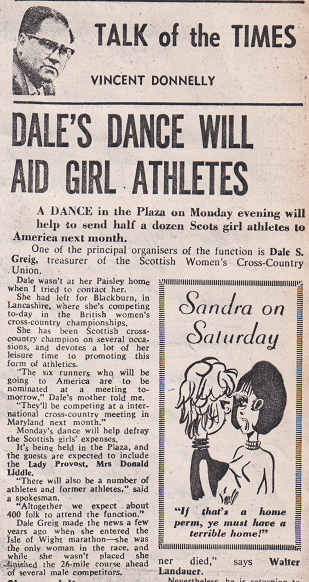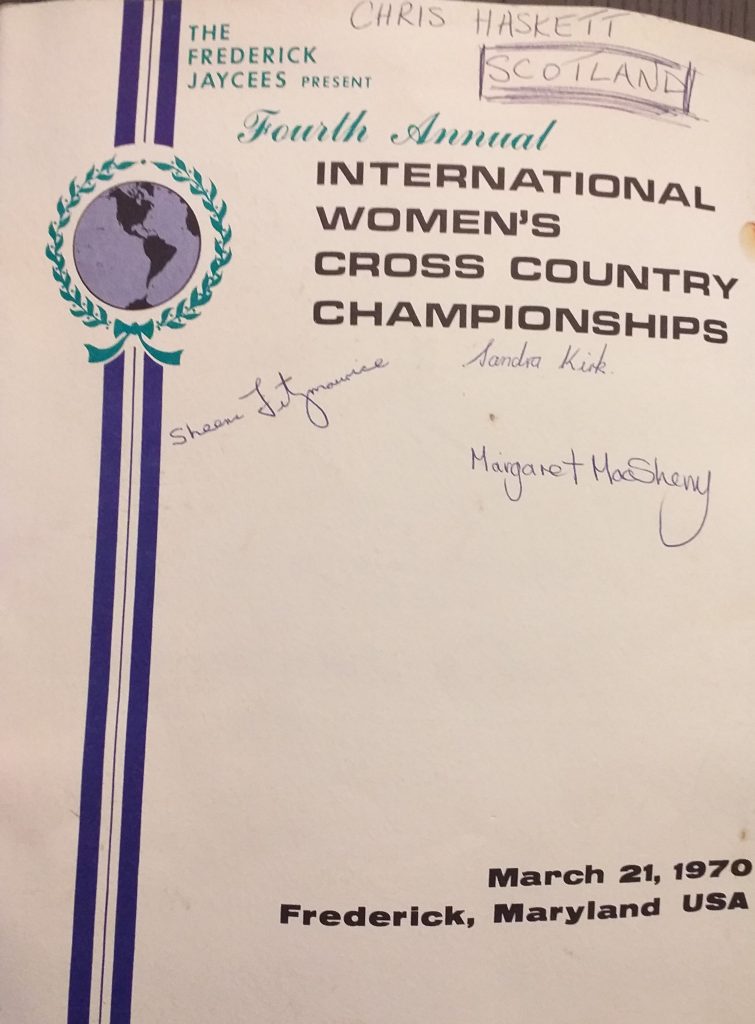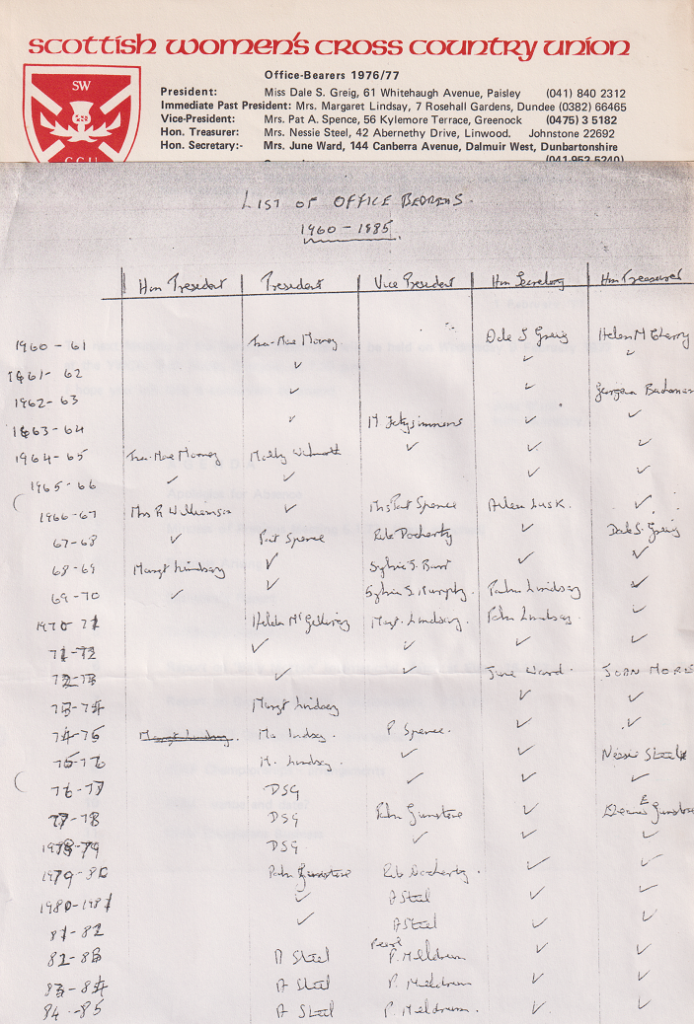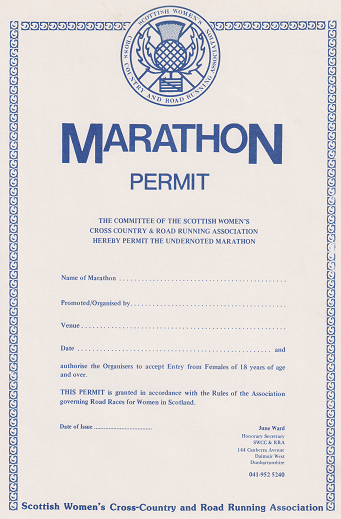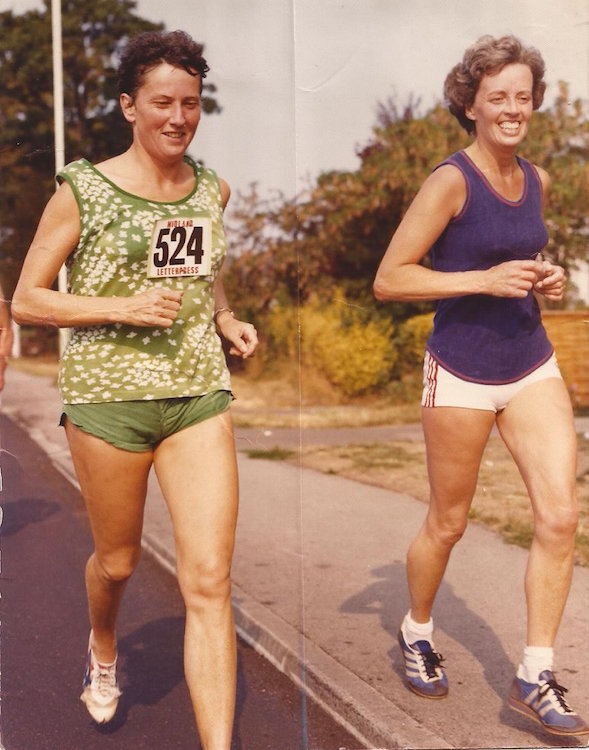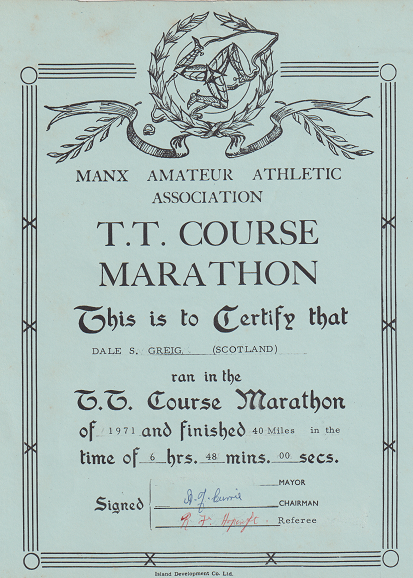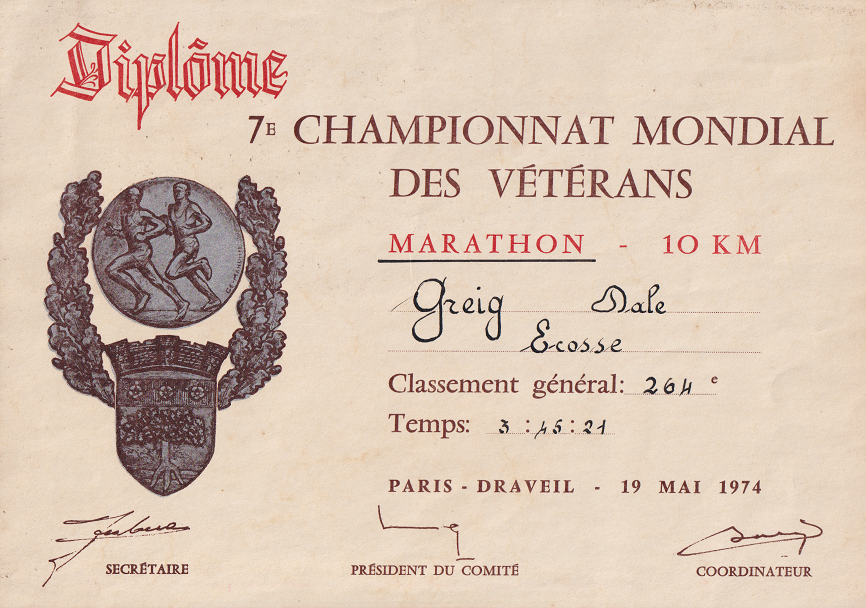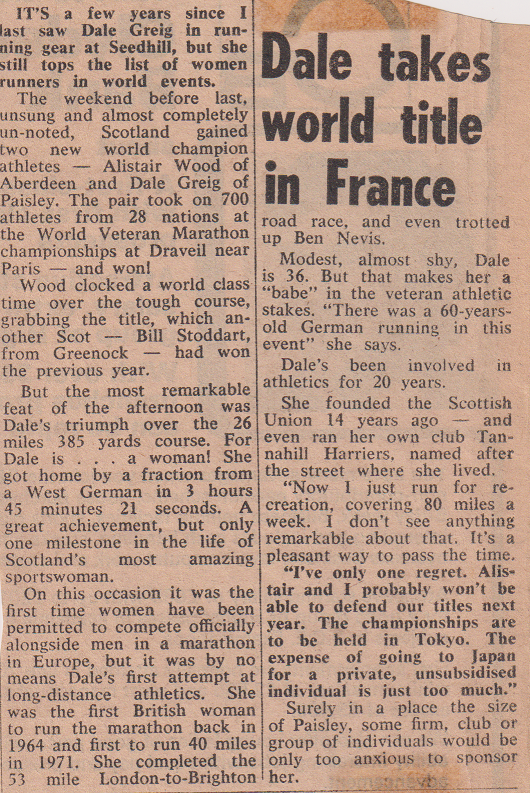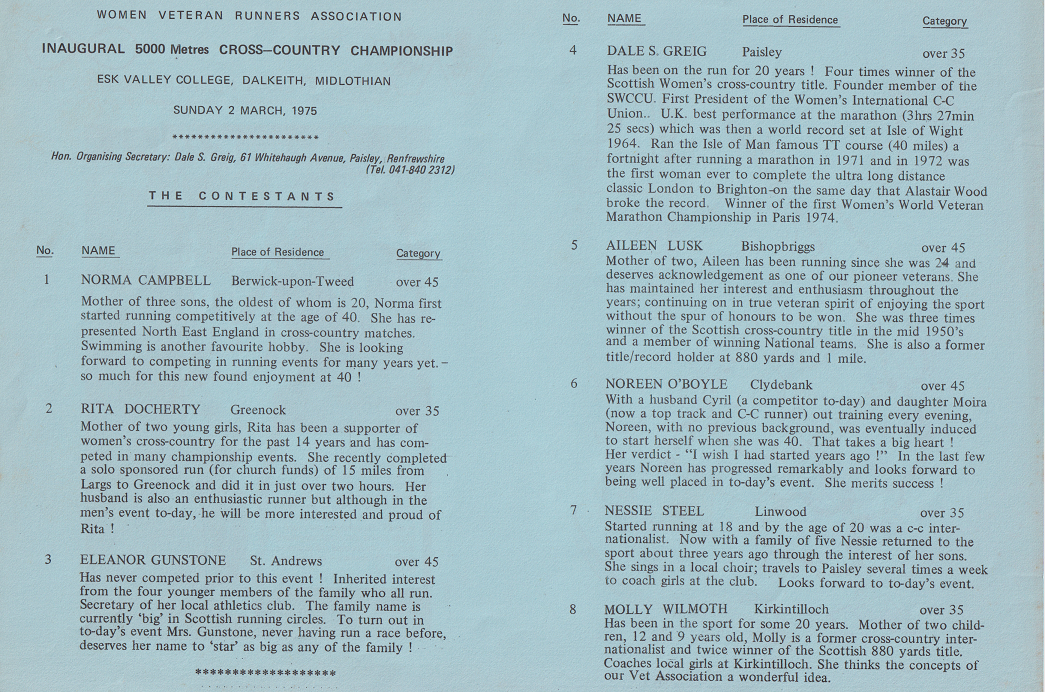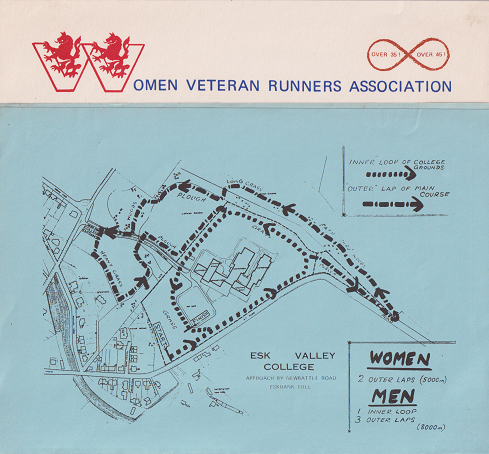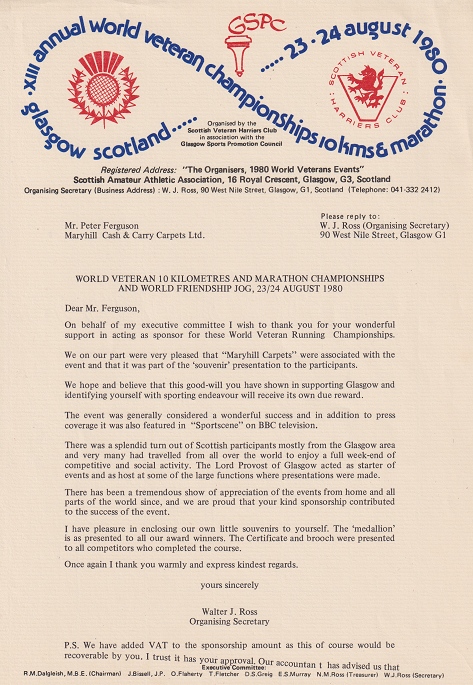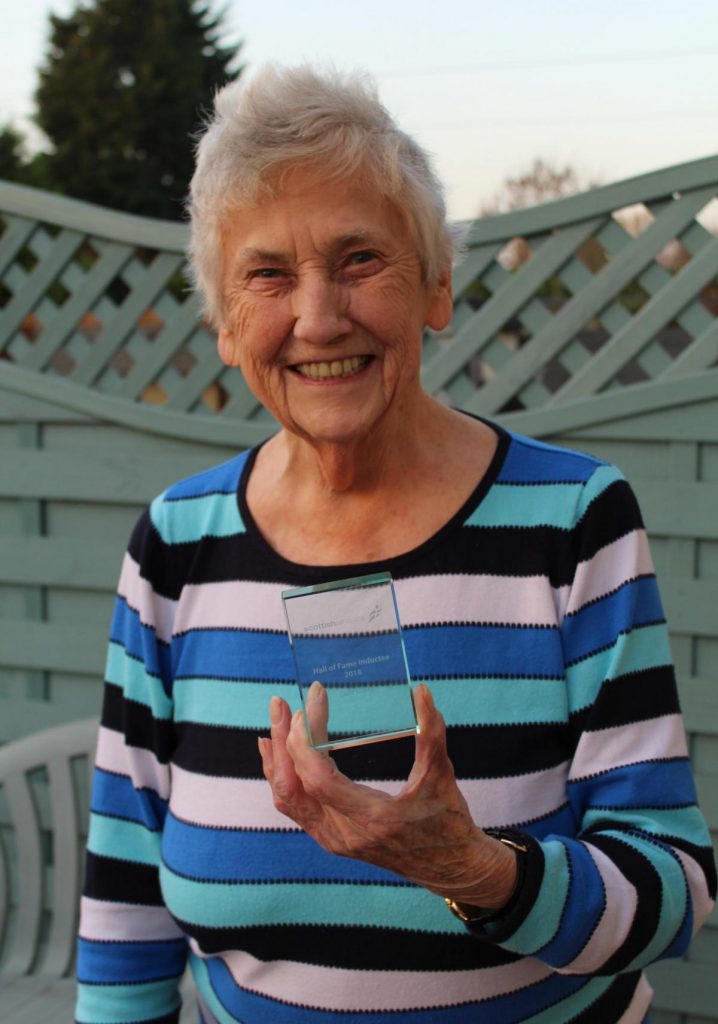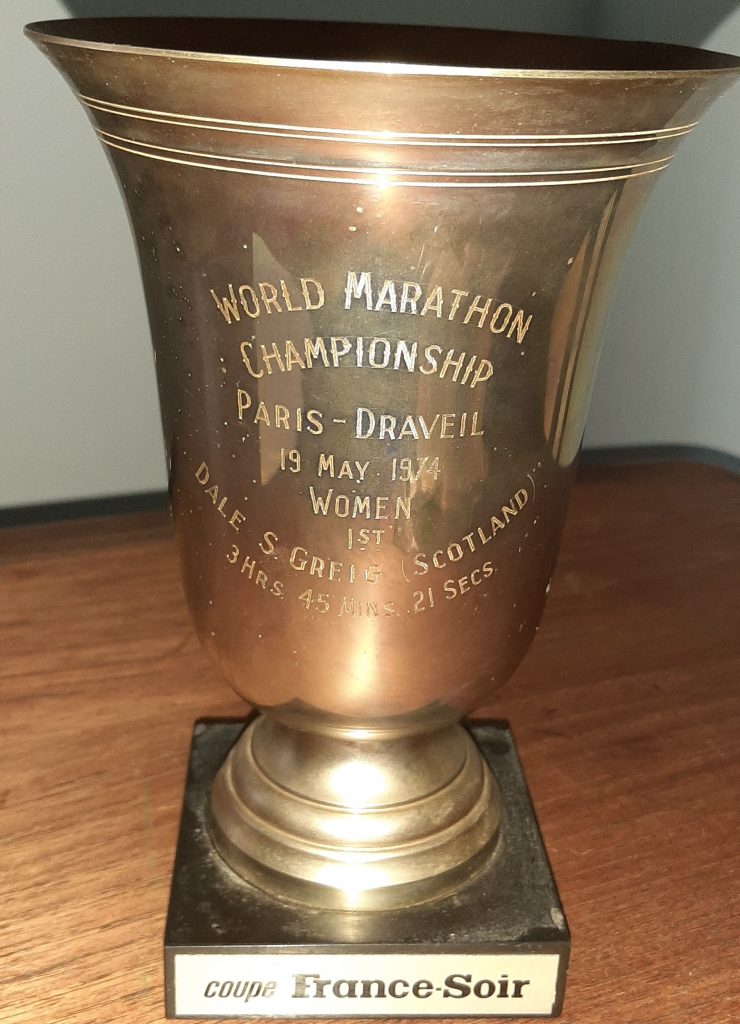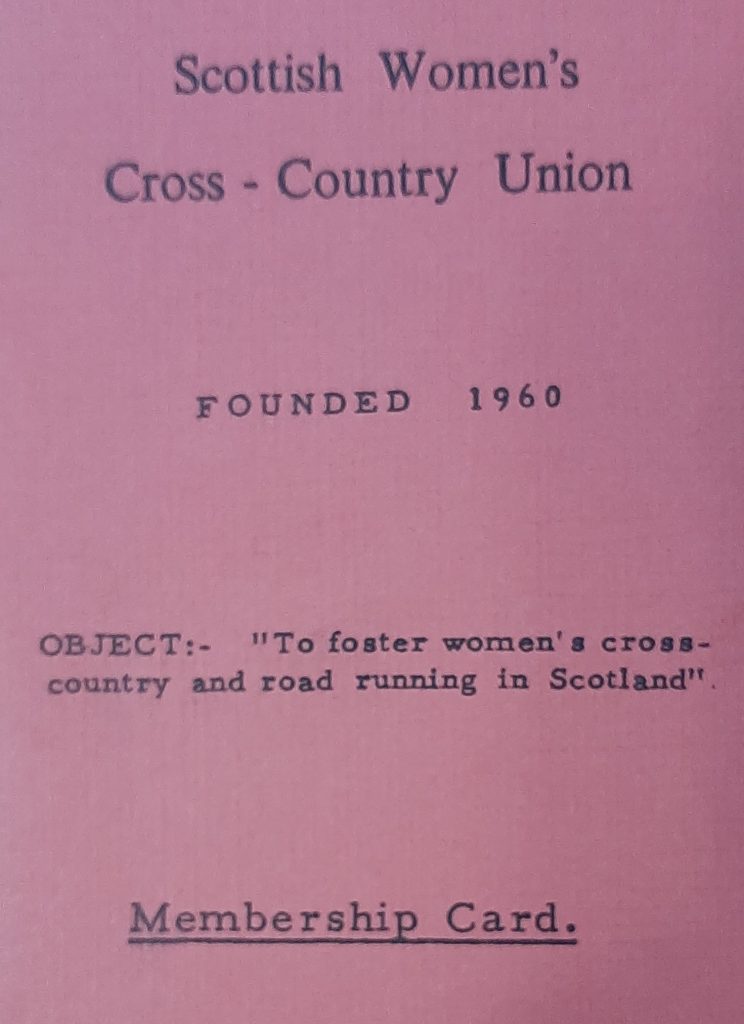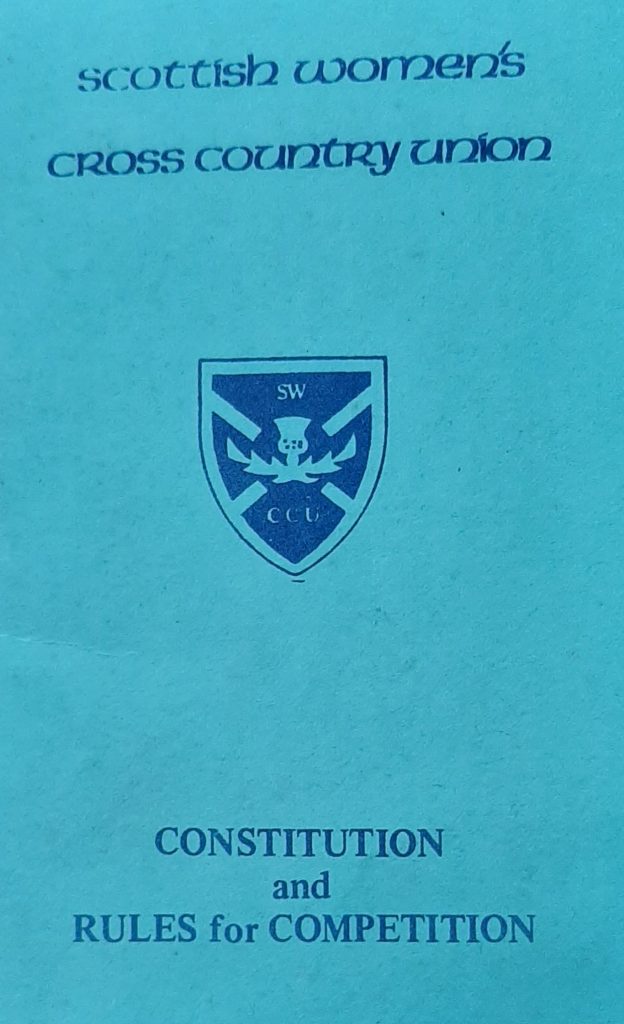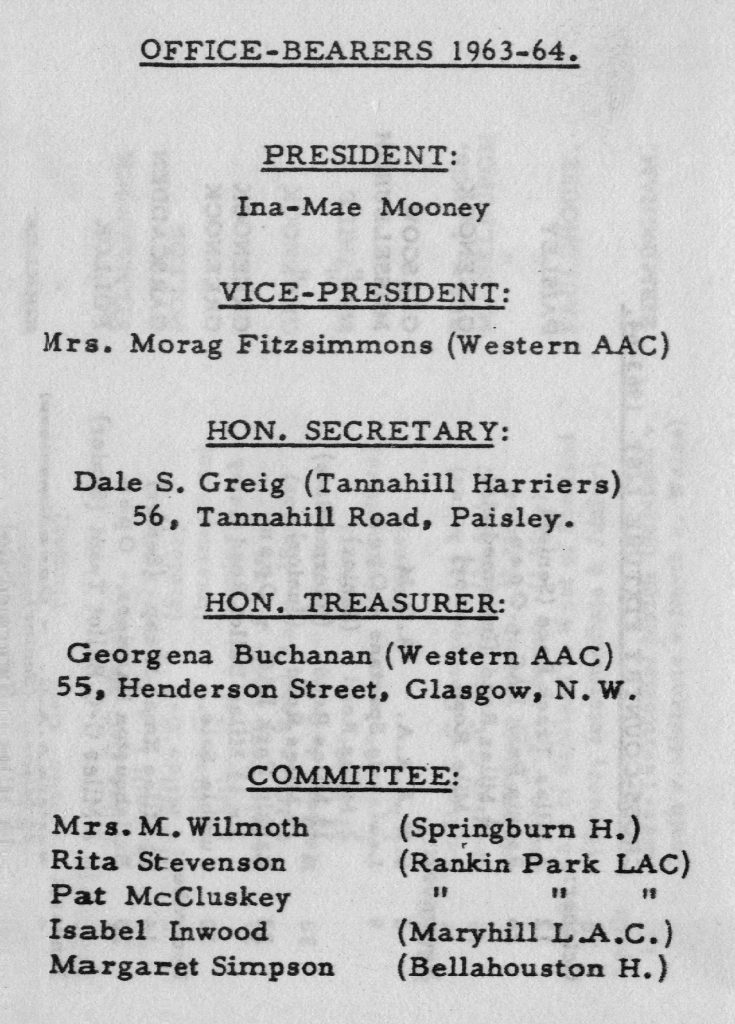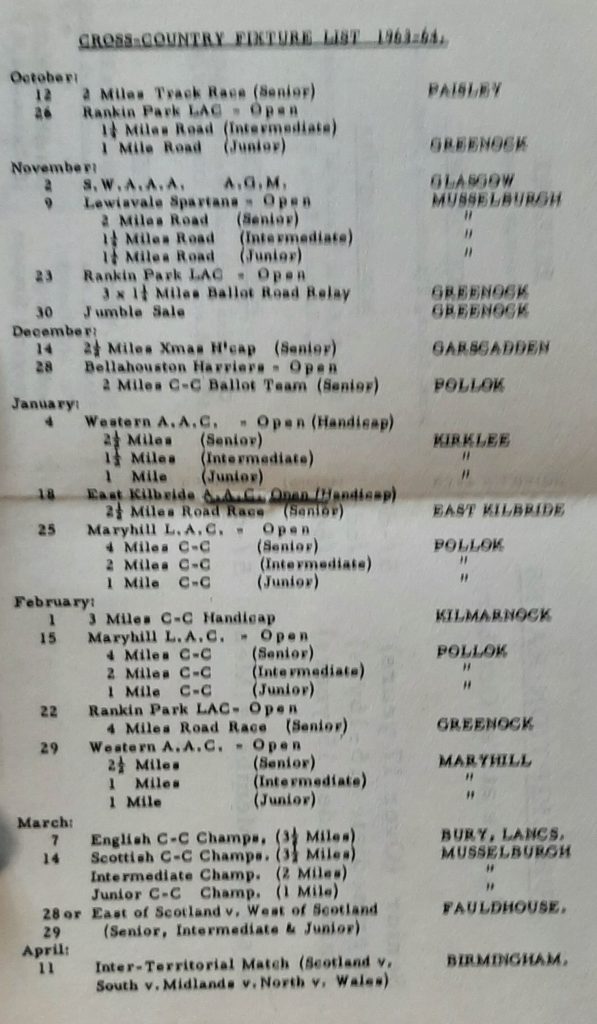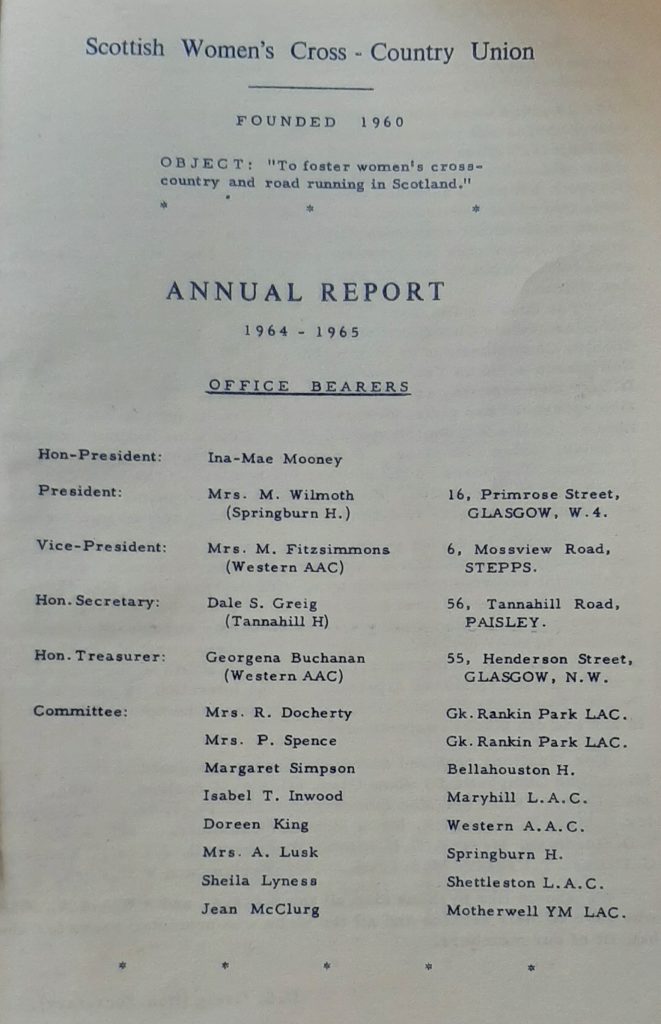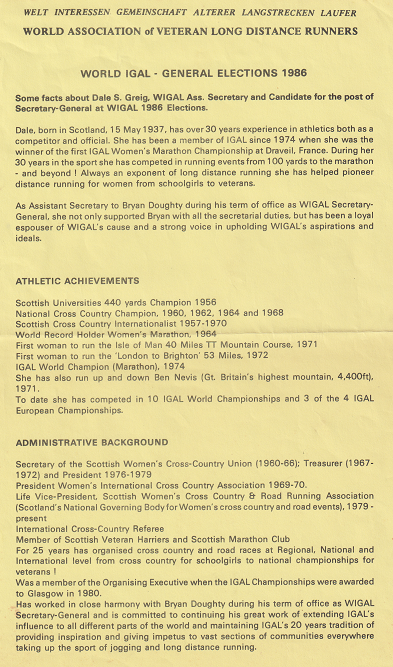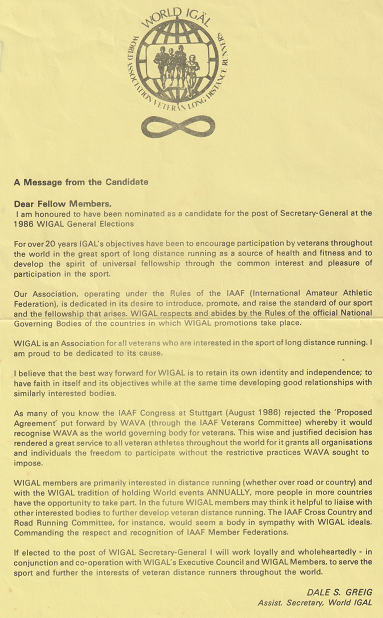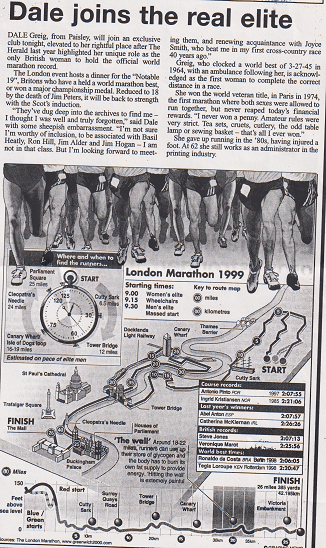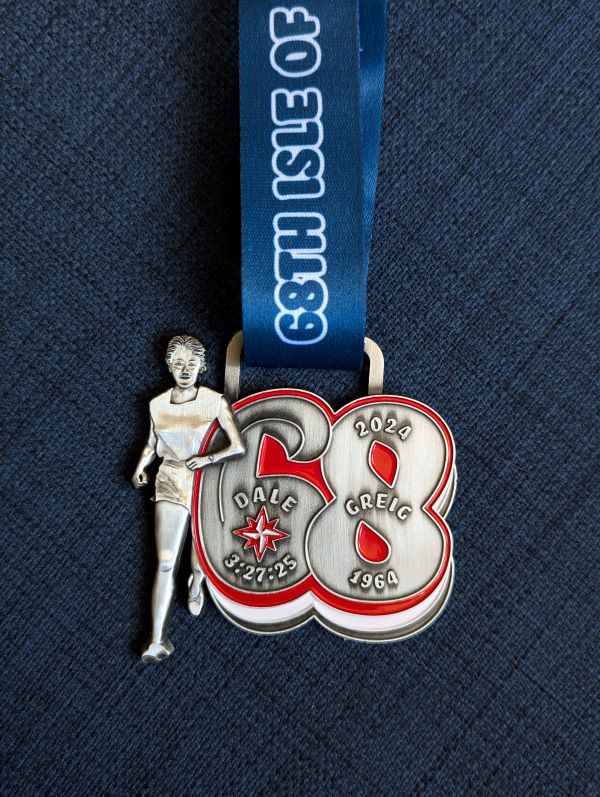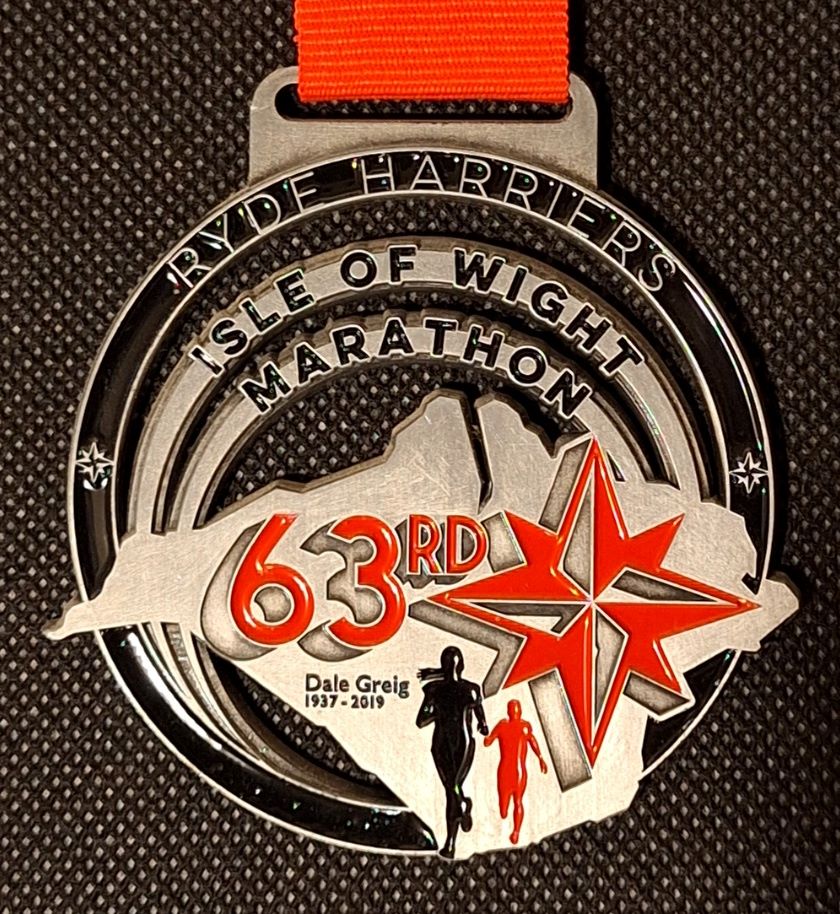Dale Greig was one of Scotland’s best ever all round endurance runners but also one of the quietest and most modest. When she died in 2019 she left a large archive of material dealing not just with her own career but with Scottish women’s athletics generally. Colin Youngson has had access to this material and his first selections from it are below.
Dale was inducted into the Scottish Athletics Hall of Fame in 2018. Here is the citation from the induction:.
“Dale Greig (1937-2019) is best known as a pioneering woman distance runner, who became one of the first women to run a marathon, and set the inaugural recognised IAAF women’s world best for the distance. Her first competition over the standard marathon distance of 26 miles 385 yards came during her annual holiday in the Isle of Wight in May 1964, where sympathetic officials allowed her to run a time-trial on the day of the race, starting 4 minutes ahead of the male competitors. Despite the hilly terrain, and being shadowed by an ambulance throughout the race at the insistence of the athletics authorities, she had no qualms about completing the distance. Her finishing time of 3 hours 27 minutes 45 seconds was remarkable, being recorded as an IAAF inaugural world best. (After this record marathon, Dale danced until midnight and rose early for a swim before travelling home.)
She went on to compete in the Isle of Man 40 miles race in 1971, finishing in 6:48:00. In hill running, she was the first woman to compete in and finish the Ben Nevis 10 miles mountain marathon race in Fort William. She ran in the classic London to Brighton 53 miles race, completing the arduous event in 8:30:04. She continued to compete on the track in mile races and won her 4th and final Scottish cross-country title in 1968. In 1974, she recorded her most notable international marathon success when winning the women’s World Veteran Championships in Paris in 3:45:21.
Her pioneering efforts opened the way for women throughout the world to be admitted to marathon races having ventured into unchartered territory at a time when some respected authorities still believed that running such long distances was harmful for a woman.”
In 1975, how did Dale sum up her own running career?
Dale S. Greig, Paisley, over 35 age-group category.
Has been on the run for 20 years! Four times winner of the Scottish Women’s cross-country title. Founder member of the SWCCU. First President of the Women’s International Cross-Country Union. U.K. best performance at the marathon (3 hrs 27 mins 25 secs) which was then a world record, set at Isle of Wight 1964. In 1971, ran the Isle of Man famous TT course (40 miles) a fortnight after running a marathon. In 1972, was the first woman ever to complete the ultra long distance classic London to Brighton race on the same day that Scotland’s Alastair Wood broke the course record. Winner of the first Women’s World Veteran Marathon Championship in Paris 1974.
Dale Greig’s paper archive has been kept by her neighbours (and close friends) Rosemary Kidd and her daughter Niki. I was lucky enough to visit and search for additional information about Dale. On the website Scottish Distance Running History, under ‘Elite Endurance’ is her profile. Under ‘The Veterans’, click on ‘The Scottish Veteran Harriers Club: The Beginnings, the 1970s’. Dale’s contribution is emphasised.
Brian McAusland, the SDRH webmaster, says about Dale, “She was a very good person. I liked her and, just like everyone else, got on well with her.”
I never met Dale but we exchanged several emails: her personality shone through. No wonder she achieved so much and was so popular. Here is a Selection from her own Archive..
Colin Youngson, June 2022.
The above article (from the Paisley Daily Express on 5th July 1971) praises Dale’s recent painful marathon on the Isle of Wight and, only two weeks later, completing the tough 40 miles race on the Isle of Man. (Her 1964 inaugural Women’s World Record over the Isle of Wight course is also emphasised, as well as her invaluable committee work with the SWCCU.)
(Two interesting facts about Dale as a youngster are that: at school, she showed promise as a sprinter; and, in 1956, she won the Scottish Universities quarter mile title.)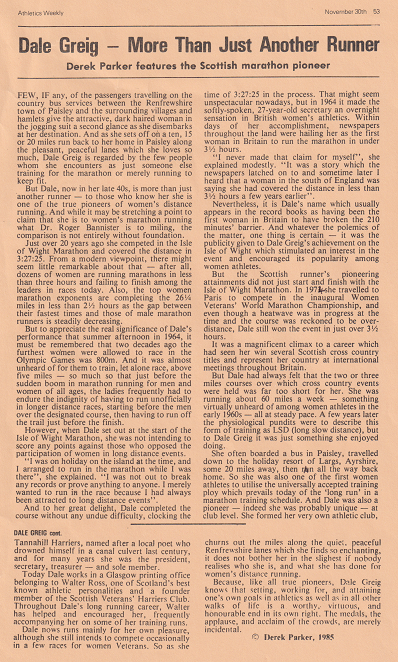
(Very unluckily, in 1982 Dale jumped into the shallow end of a swimming pool. “They were changing the water and it was shallower than it might have been. I hit my heels on the bottom, and suffered cracked bones in my feet. I was never quite the same again.”)
In 1997, Dale remembers the experience of being the first Woman to run the London to Brighton ultramarathon in 1972 (seven years before female athletes were permitted to take part officially). Dale was amused when, at 46 miles, the route crossed ‘Dale Hill’. She must have smiled modestly at her description above as ‘the first lady of British distance running’.
SWCCU Christmas card
A letter from the SWAAA secretary, replying to Dale about the proposed formation of the Scottish Women’s Cross Country Union. Below is Dale’s thoughtful, enthusiastic, polite reply.
Dale was SWCCU champion four times: 1960, 1962, 1964 and 1968. Her durability as an athlete was obvious: she ran for Scotland in the ICCU International event in 1957 and in 1968. The 1968 International was held in Tunis. England, Ireland, Wales and Scotland took part as well as the United States of America. 30 athletes participated and the Scottish team did well to finish third, beating Ireland and Wales. Doreen King, who had been the 1961 SAAA One Mile champion, was first Scot in 12th, with Margaret MacSherry 13th and Scottish champion Dale Greig 14th. Good packing! Leslie Watson was fourth counter in 16th, Rosemary Stirling 17th and Sheena Fitzmaurice 19th.
The Dance at the Plaza (mentioned above) was to raise funds to help a Scottish team to take part in the 1970 International Cross Country Championships. For Women, one race took place (along with all the Mens’ contests) in Vichy, France on 22nd March. The distance was 3km, 23 ran, Paola Pigni (Italy) won, and The Netherlands were first team, from Italy, France, Poland and Belgium. An ‘alternate’ Women’s Championship had been held a day earlier (21st March), at the FVW Country Club in Frederick, Maryland, USA. The distance was 4km, 34 ran and Doris Brown (USA) won. The winning team was England, from USA, Canada, Ireland, Scotland and Wales. Since four counting finishers were required, and Australia only had two, they did not complete a team. The teams in front of Scotland had six or five competitors, while Scotland only had four: Margaret MacSherry (6th), Christine Haskett (8th), Sheena Fitzmaurice (26th) and Sandra Kirk 28th). Christine Haskett (now Price), who went on to enjoy a long and very successful athletic career, recalled that Sheena doubled as Team Manager and two others helped during this exotic adventure in the USA: SWCCU President Hilda McGillivray; and Treasurer Dale Greig
Below, note that Dale Greig served the SWCCU as President, Secretary and Treasurer, and then became Life Vice-President for the SWCCU and Road Running Association. In 1980, when the World IGAL (Veteran) World Championships came to Glasgow, she was on the organising committee. Between 1982 and 1987, she was Assistant Secretary of World IGAL. Dale became an Honorary Life Member of the Scottish Athletics Federation and the Scottish Veteran Harriers.
Note that the SWCCU has added Road Running to Cross Country. Wonder who might have pushed for that inclusion?
Dale (left) with Aileen Lusk. The photo was taken in 1976, when Dale finished tenth Woman in the World Veterans Marathon at Coventry. Aileen ran the 10k at that championship and here was encouraging her friend Dale.
Isle of Man newspapers remarked:
“A surprise entry in the 26 starters was Scots girl Dale Greig. She managed to finish the gruelling 40 miles as ‘tail-ender’ in a time of 6 hours 48 minutes. This is a remarkable achievement for the first-ever girl to compete in the Tourist Trophy circuit marathon.
“An unexpected runner was a lady, 34 years old Dale Greig from Paisley, who commenced the circuit one hour before the start of the race, and completed the course, undistressed, in 6 hrs 48 mins.” (Women were not allowed to race this event officially until 1982.)
(Another pioneering effort by Dale Greig was in September 1971, when she became the first Woman to complete (unofficially) in the gruelling uphill and downhill ten miles Ben Nevis Race on Britain’s highest mountain. An Aberdeen newspaper reported that “174 men and one girl” took part. 140 men finished; and Dale’s time indicates that she was faster than nine of them.)
Dale finished first Woman in the inaugural World Veteran Marathon Championships in May 1974. (Walter Ross completed the course in exactly the same time!) The course was hilly and rough underfoot and the weather was uncomfortably hot. Scotsman Alastair Wood (Aberdeen AAC) won the Men’s title. (When, in 1972, Dale became the first Woman to complete the London to Brighton 53 miles ultra-marathon, Alastair Wood won the Men’s race and broke the course record.)
As a Veteran, Dale went on to compete in ten IGAL Championships and three European Championships. For example, in 1976 she competed in the World Veterans Marathon in Coventry and finished tenth woman in 3.39.44. (IGAL stands for a German phrase which translates as ‘The Partnership of Older Long Distance Runners’ – this organisation was formed in 1968.)
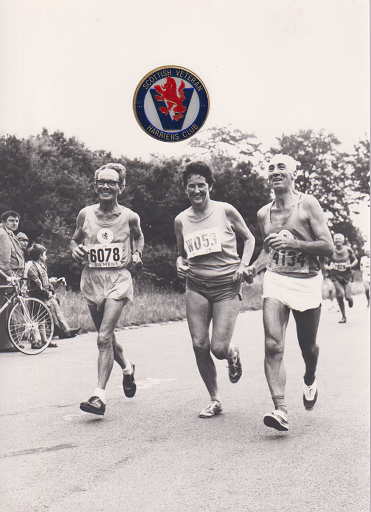 The above photo was taken during the July 1977 Veteran World Championships in Brugge, Belgium. Dale (centre) has great friend Walter Ross on her left, and, on her right, like Walter wearing a Scottish Veteran Harriers vest, possibly Bill Ramage (Springburn Harriers).
The above photo was taken during the July 1977 Veteran World Championships in Brugge, Belgium. Dale (centre) has great friend Walter Ross on her left, and, on her right, like Walter wearing a Scottish Veteran Harriers vest, possibly Bill Ramage (Springburn Harriers).
1974-5 on 2nd March at Dalkeith: Norma Campbell (Blaydon H) 22.12, Noreen O’Boyle (Victoria Park AAC) 23.21, Dale Greig (Paisley H 25.51), Aileen Lusk (West) 27.06, M Steel (Paisley) 27.45, R Docherty (Greenock) 28.39. (Norma Campbell was actually 46 years old.)
This 1975 race was the inaugural Scottish Women Veteran Runners Association Championship, organised by that well-known marathon and cross-country runner Dale Greig. In 1975, 1976 and 1977, this event was held at the same venue and and on the same day as the Scottish Veterans XC Championships, but over a shorter course (5000 metres) than the men ran. Prizes were awarded to successful competitors in two age groups: over 35; and over 45.
1975-6 No SWVRA result has been found, but first Veteran in the SWCCU championships was Dale Greig, closely followed by Noreen O’Boyle.
1976-7 on 5th March at Coatbridge: Pearl Meldrum (Grangemouth) 21.15, Norma Campbell Berwick AC, 22.38 Dale Greig Paisley H 23.53, Aileen Lusk (Bishop) 24.29, E Steedman (Edin) 24.36. (The second and last result found for the SWVRA championships.) In the previously held SWCCU event on 19th February at Dumbarton, Pearl Meldrum was first Vet (and part of the winning Glasgow AC Senior team); with Dale Greig second Vet.
Dale Greig’s Scottish Women Veteran Runners Association cross-country championships ceased after the 1977 event, almost certainly because this was an idea ahead of its time and there were too few entrants to continue.
Not until 1984 did the SWCCU Championships include an official W35 category.
Jack MacLean wrote, “One of the unsung pillars of the Scottish Veteran Harriers Club was Dale Greig. She worked in Glasgow for Walter Ross in his printing and publishing business and, as well as typing the newsletters, she did a tremendous amount of work behind the scenes.
Along with Walter Ross, Greig was a member of the Organising Executive when the IGAL Veterans World Championships came to Glasgow in 1980. The event was supported by the city council and was a huge success with hundreds of runners from 26 countries running in the 10k and marathon races. Greig served as IGAL Assistant Secretary from 1982 to 1987.
When Walter died in April 1993, Dale wrote this eloquent, heart-felt tribute.
“The Great Enthusiast
For the first time in years, I know my telephone will not ring late tonight, previously a frequent feature of my evenings, for although I saw Walter at work every day, there would often be a late night call, an encore, an epilogue to the day’s activities; some business to discuss or just some piece of news or ‘tittle-tattle’ to impart. The silent bell, as the day ends, speaks volumes. More than anything it brings home to me the realisation that Walter J Ross, my long-time friend and colleague is gone, and that his voice will be heard no more.
Yet whilst mourning his death, those of us who knew him well will not lose sight of the important thing – that he did live, a life of struggle in many ways, but a life full of meaning. He has left all who know him and associated with him the memory of a true friend for whom service was more important than success and the joy and purpose of life. He was just 27 years old when he first published ‘The Scots Athlete’, regarded now as a great historical reference for the sport. Just as that publication was the articulation of the young man’s vision, so the founding of the SVHC in 1970 shows he still had the same vision and vigour when he had passed his 50th birthday. He had stayed the distance.
Walter was one of those mortals who never grows old. He retained that youthful enthusiasm, competitive spirit and robustness of purpose that was an inspiration to us all. His running activities took him all over the world, and when he wasn’t competing in races he was ‘running’ them (!), the most notable being the World IGAL championships (10K and Marathon) which he brought to Glasgow in 1980.
“Nothing great was ever achieved without enthusiasm” (Emerson) was a bye-line that ‘The Scots Athlete’ carried for many years, Walter was enthusiasm personified in everything he tackled. He was a great champion too of women’s struggle for advancement, particularly in sport.
When I helped found the Women’s Cross-Country Union in 1960, this too was Walter in the background with another of his ‘marvellous’ ideas!
I did not expect his life to end suddenly in the way it did. Unfortunately, death is no respecter of persons or age. As Omar says: ‘The moving finger writes, and having writ, moves on’. It is, knowing him, a happy thought that his courage, determination and mental vigour remained undiminished to the end. I last saw him some 36 hours before he died, when, ever the optimist, he asked me to make travel arrangements so that he could have a holiday when released from hospital! And so, at last, farewell, dear friend. But not to forget .. only a kind of chastened au revoir. In spirit you are with us always!”
Another great enthusiast, Dale Greig, should also be remembered with admiration and affection.
Dale is holding a small Scottish Athletics plaque, inscribed “Hall of Fame Inductee, 2018”
INTERVIEW WITH PALM GUNSTONE:
Palm Gunstone (nee Lindsay) was a Scottish International Cross-Country runner who served on the SWCCU (Scottish Women’s Cross Country Union) committee as Secretary, Vice President and President. Palm and Dale were colleagues and friends. She was interviewed in 2022 and the following information was gleaned.
SWCCU: In committee, Dale Greig’s ideas were usually accepted. She was respected and well liked.
In March 1970, Dale was partly in charge of a small Scottish team (four runners, four to count) which finished behind England, USA, Ireland and Canada but in front of Wales in the ICCU Cross Country Championships in Frederick, Maryland.
SWCCU championships never produced race programme booklets. Clubs and individuals could enter, then pick up race numbers at the venue. Palm thinks that Anglo-Scots could turn up and enter on the day.
Once June Ward (Victoria Park) became SWCCU Secretary (1972-1992), she became influential. She was advised by Philip Nash (who formed a short-lived club called Strathclyde Ladies, then joined Victoria Park) to allow Scotland to compete as a County in the Northern Counties Championship. This allowed access to a sequence of twelve cross country events (ten to count, with individuals earning points/selection). Although Scottish runners wore a blue vest, it had ‘Scottish League’ on the front. A Scottish badge was awarded, but runners were not allowed to sew it on the vest. Palm Gunstone remembers that, in the early 1970s, she did run in this Inter-league. December 1971 event was at Birmingham (where Palm was 23rd and first Scot. She also competed in Derby and Rawtenstall.
The Home Countries CC International fixture was revived in 1975 at Coatbridge. By 1979, five nations were involved (Scotland, England, Wales, Northern Ireland and Ireland).
Scottish cross-country runners were utterly dismayed when, after the 1987 IAAF World Cross in Warsaw, only a GB team participated, rather than Scotland and each of the other Home Nations.
In 1993, just after SAAA, SCCU, SWCCU amalgamated to form Scottish Athletics Limited, there was controversy.
£10,000 had been raised by SWCCU. This sum was intended to finance organisation and travel expenses for Scottish Women to compete in important races. Eleanor Gunstone (SWCCU Treasurer 1977-92 and awarded Honorary Life Membership in 1992) had been opposed to this amalgamation. Backed by Dale Greig and June Ward, she retained the cash, rather than passing it to SAL. (The fear was that this money would go towards Male officials and runners.) Eventually, this went to court and Eleanor Gunstone won the case. Henceforth, the money was ring-fenced for Female runners. (Both Eleanor and the main SAL Male officials ‘lost face’; but Eleanor Gunstone went on to become SAL President (1996-1999).
Dale Greig always lived in Paisley, sharing a house with her mother (until she died); then, after the death of her twin sister Cynthia’s husband and carer (Alex Kidd, Scottish International cross-country runner), Dale cared for her twin sister (stroke, death). Thereafter, Dale was on her own. Dale was very private indeed. Palm Gunstone was surprised, when she visited the house, to find that it was a large Victorian property. Dale owned the bottom half of this building. (Palm drove Dale to Rita Docherty’s funeral). Palm regretted that she was on holiday abroad and could not attend Dale’s funeral; but Molly Wilmoth (former Scottish International athlete and dedicated official) was there.
Rosemary Kidd was connected with Dale because of a link with Cynthia’s husband (Alex Kidd). Rosemary’s husband Joe (Niki’s father) was Alex Kidd’s brother. Dale eventually became ‘family’ and, in her later years, even very private Dale confided to some extent with Rosemary and Niki.
That was how Rosemary and Niki ended up with Dale’s paper archive. How did Niki know Dale? They visited Dale in Paisley.
ARCHIVE ADDITIONS
Sincere thanks again to Rosemary, Niki (and Running Historian Katie Holmes, who took the following photos), since valuable material can now (2023) be added.
Tannahill Harriers Constitution
1 The club shall be called Tannahill Harriers
2 The object of the club shall be the promotion of Amateur Athletics and Cross-Country running, and the Membership shall be strictly confined to Amateurs.
3 The Annual General Meeting shall be held on the first week of September. The Secretary’s and Treasurer’s reports shall be submitted, and the Office-Bearers, Committee and Auditors for the ensuing year elected.
4 The Office-Bearers shall consist of a President, Vice-President, Hon. Secretary and Treasurer, and Committee of three members by whom the affairs of the club shall be managed.
5 Meetings of Committee shall be held as often as thought necessary by the Secretary. Four members to form a quorum.
6 The business transacted at General and Committee Meetings shall be minuted by the Secretary – such minutes to be submitted to each succeeding meeting for approval.
7 The Annual Subscription shall be 7/6d or, if under 19 years of age on 1st October, 2/6d, which sum shall be due and payable on 1st August and not later than 31st October in each year and must be paid before participating in club races.
8 Any member wishing to resign from the club must give written notice to the Secretary previous to the Annual General Meeting, or be liable for another year’s subscription.
9 Any member violating the rules, or doing anything prejudicial to the interests of the club, may be expelled from the club by the votes of two-thirds of the full committee.
10 Any member can appeal against the decision of the committee to a General Meeting of the club.
11 The club uniform shall be all-white singlet with green shorts.
12 No alteration in or addition to the Rules shall be made except at the Annual General Meeting, or at a Special General Meeting called for that purpose. Ten days written notice of such proposed alteration or addition shall be given to the Secretary.
OFFICE-BEARERS
President: Walter J. Ross
Vice-President: Margaret McEwen
Secretary/Treasurer: Dale Greig, 56 Tannahill Rd., Paisley.
Committee: Winifred Holmes, I. King, J. Sinclair
(Dale founded this one-person club, then persuaded a few friends to join. In 1959-1960, the very last occasion when the Scottish Women’s Amateur Athletic Association organised the Scottish Cross-Country Championships, Dale won the individual title, her team-mate Patricia McCluskey was second and K. McNicol 17th. Consequently, Tannahill Harriers won the Scottish team title, by three points from Springburn Harriers, with Ardeer Recreation third. However, in 1961, Patricia was running for Greenock Rankin Park when she won the title (from Dale in second place). Patricia’s club finished first team that year. Dale continued to represent Tannahill Harriers when she regained the individual title in 1962 (by a clear 48 seconds), 1964 and 1968.)
(The newly-formed SWCCU organised the Scottish Cross-Country Championship in 1960-1961 and for another thirty years.)
SUBSCRIPTION RATES
To become a member of the SWCCU in the early 1960s seems nowadays to be amazingly inexpensive: (age as at 1st October) – Senior (over 17 years) = five shillings; Intermediate (15 to 16) = two shillings and sixpence; Junior (under 15 years) = one shilling and sixpence. Associate Members (Men) = five shillings.
In 1999, and for several years thereafter, Dale Greig was invited to the London Marathon. As the article above makes clear, she was an honoured guest, along with other British athletes who had been prominent in important marathons or had broken major records. The ‘Notable Nineteen’ was to become the ‘Terrific Twenty’ and then, the ‘Terrific Twenty-One’ when Paula Radcliffe joined this select group. (Paula won the London Marathon in 2002, broke the Women’s World Record in London 2003 and became World Marathon Champion in 2005) The article above mentions that the 1999 course record was still held by Norway’s Ingrid Kristiansen (the first woman to win world distance running championships on three surfaces: cross country, track and road). Ingrid and Dale obviously got on well, since Ingrid posted (from her home address) a photo of the smiling pair at the London Marathon. There was a message in Norwegian, which Ingrid translated for Dale as ‘Thanks for the Inspiration‘!
In 2024, Ryde Harriers, which still organise the annual race, celebrated the 60th anniversary of Dale Greig’s pioneering exploit in the 1964 Isle of Wight Marathon. Katie Holmes, Independent Sports Historian and a great admirer of Dale, organised an exhibition for the club. Here is a photo of Katie with club captain Trevor McAlister. Katie has signed a contract to write a book about women’s distance running in the UK. This will include chapters on Dale Greig and Leslie Watson.
On October 6th 2024, Katie succeeded in finishing this challenging marathon, despite finding the hills pretty hard.
The final two photos are of beautifully designed medals in honour of Dale Greig. Fitting tributes to a great runner.
The 2024 marathon medal
A 2019 commemorative medal celebrating Dale Greig
